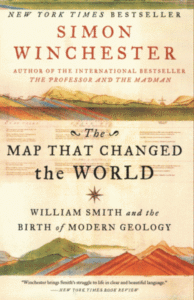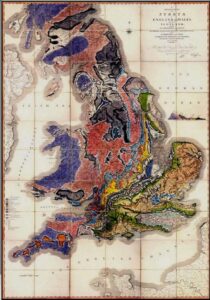In addition to be the campus director, I also teach SCI 155 – Environmental Earth Science. We manage to cover all of those topics any introductory earth science should cover (you know…rocks, minerals, plate tectonics, earthquakes, climate etc….). But, I also like to assign a book for class discussion that may not make it onto the reading list of your normal earth science course.
I’m a big fan of Simon Winchester’s popular books covering many different aspects of the earth sciences from a very approachable (story behind the science) angle. So, the class are reading his 2001 book The Map That Changed The World. It’s the story of one of the founders of the science of geology, William Smith. Smith was a canal builder in Somerset, England, who in the late 1790s and early 1800s realized that sedimentary geology followed a logical distribution on and under the landscape. He found that by ‘tracing the placement of fossils, which he uncovered in his [canal] excavations, one could follow layers of rocks as they dipped and rose and fell – clear across England and, indeed, clear across the world – making it possible, for the first time ever, to draw a chart of the hidden underside of the earth‘ (Winchester).
Smith toiled for years compiling his data on the distribution of rocks, identified by their mineralogy, texture, and fossil composition, and eventually in 1815 published the first ever geological map. He should have been hailed as a genius, but instead he ended up in debtors prison and was left virtually homeless for years. It wasn’t until 1831 that his work was recognized with an award from the Geological Society of London. Smith is now considered as one of the founding fathers of the science we now know as geology.
Many science courses present the science without presenting the background. I love presenting an understanding of how science has developed, early challenges, and even putting human story behind some of the biggest discoveries in the field.


